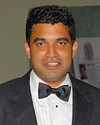2008 Awardees

Zev Bryant
Stanford University
Project Title: Engineering Molecular Motors
Grant ID: DP2-OD004690
Molecular motors lie at the heart of biological processes from DNA replication to cell migration. The principal goal of my research is to understand the physical mechanisms by which these nanoscale machines convert chemical energy into mechanical work. I propose a radical change in the way my laboratory approaches this goal. We will rigorously challenge our understanding of the relationships between molecular structures and mechanical functions by rationally engineering molecular motors with novel properties. The performance of our designs will illuminate both the inner workings of natural biological motors and the general operational constraints for producing directed motion on the molecular scale. Ultimately, construction of molecular motors to arbitrary specifications will provide a powerful toolkit for synthetic biology, therapeutics, and nanotechnology. My laboratory will design and characterize molecular motor variants using a rapid testing cycle that relies on new instrumentation for high throughput single molecule tracking and manipulation assays. We will focus our efforts by choosing a small number of ambitious design targets, each requiring several intermediate molecular innovations and optimizations. For the period of this award, two initial design targets will be pursued, leveraging our existing expertise in myosin and topoisomerase mechanochemistry. Success will represent an unprecedented level of control over nanoscale motion, building an engineering capacity that will eventually be used to design protein nanoassemblies capable of sophisticated intracellular therapeutic functions such as genome repair. Novel molecular motors will also have ex vivo applications including molecular sorting and assembly of nanoelectronics in microfabricated devices.

Ronald J. Buckanovich
University of Michigan at Ann Arbor
Project Title: Using Embryonic Stem Cells to Re-Create a Human Tumor Microenvironment to Develop Ovarian Cancer Therapeutic and Diagnostic Tools
Grant ID: DP2-OD004197
Tumor vasculature expresses unique markers that represent novel immunotherapeutic targets. Development of anti-vascular immunotherapeutics, with few exceptions, has been hindered by the absence of a tumor model with human tumor vessels. A new tumor model, combining human embryonic stem cells (ESC) and tumor cells, develops abundant human vessels. It is unknown if these are ‘normal’ or ‘tumor’ vessels, expressing tumor vascular markers (TVMs). We hypothesize that ovarian cancer cells will induce human ovarian TVM expression. We propose (1) to characterize ovarian TVM expression in an ESC-ovarian cancer model for the development of anti-vascular immunotherapeutics. We recently identified over 70 ovarian TVMs. Many ovarian TVMs are not expressed in normal tissues or other tumors. Tumor specific expression, expression at the earliest stages of tumor development, and direct exposure to blood, suggest that TVMs are ideal biomarkers for both ovarian cancer diagnosis and targeted immunotherapy. We propose (2a) to test anti-ovarian TVM antibodies as diagnostic tools and, (2b) to couple anti-ovarian TVM antibodies with toxic nanoparticles and test them as immunotherapeutics using the ESC ovarian tumor model. Finally, our preliminary data suggest that the ESC-ovarian tumor model has human tumor vascular cells. Tumor vascular cells are critical for the growth of tumor stem cells, which reside within the vascular niche. One challenge with characterizing tumor stem cells has been finding appropriate conditions for in vivo growth. We hypothesize that the ESC ovarian tumor model, with human vascular cells, will provide an ideal microenvironment to support human stem cell growth. We therefore propose (3) to isolate ovarian tumor stem cells and grow them in vivo using the ESC ovarian cancer model. If successful, this will create a murine tumor model that nearly completely reproduces the human tumor microenvironment with human tumor stroma, vessels and tumor stem cells.

Timothy J. Cardozo
New York University School of Medicine
Project Title: Chemical Biology Design for Malaria
Grant ID: DP2-OD004631
An effective molecular design successfully captures the balance, proportion and rhythm of a specific biomolecule while respecting the unity of the biomolecule with its cellular, tissue, whole organism and ecological surroundings. I propose to lead the design of a drug that crosslinks two proteins of the gliding motility machinery of P. falciparum: the causative agent of malaria. This molecule will be a novel malaria treatment operating directly at the complicated host-pathogen interface and influencing the enormous global health burden of this disease. First, the inter-locking parts of the gliding motility machinery will be visualized by a combination of novel molecular modeling approaches and X-ray crystallography. Of note, three-dimensional visualization of the first interlocking part failed via either of these approaches separately, but we succeeded by cleverly deploying them in an integrated fashion. Additional interlocking pieces of the gliding motility machine are already being unveiled by this unique approach, so we are confident that we can visualize the intricacies of a large bloc of the molecular machine in its in situ configuration. Second, exploitable pockets in the whole machine will be targeted for drug design via a combination of in silico screening of chemical databases and novel cheminformatics techniques. We describe how this integrated approach revealed a hitherto unrecognized “druggable” site, allowing the biology to guide the design.

Karen L. Christman
University of California San Diego
Project Title: Engineering a Dynamic Extracellular Matrix Microenvironment
Grant ID: DP2-OD004309
In the fields of biomaterials and tissue engineering, the ability to modulate cell behavior on surfaces is essential, particularly when attempting to direct cell growth and differentiation, both for in vitro engineered tissue and generating cell sources from progenitors and/or stem cells. A major area of work in tissue engineering is the development of artificial extracellular matrices or scaffolds. The extracellular matrix in vivo is a dynamic entity that often shifts between a composition of one distinct set of components to another. This matrix remodeling is especially common during development, differentiation, and wound repair. A dynamic engineered matrix that emulates this situation in vitro has yet to be developed and would have a huge impact in tissue engineering and regenerative medicine. For example, one of the biggest challenges to realizing stem cell therapies is the ability to take a premature cell and differentiate it into the desired phenotype. While soluble factors and static matrices have been examined for accomplishing this goal, the technology that could mimic the developing extracellular matrix, which is known to regulate cell survival, migration, proliferation, and differentiation, has not been developed. The principal investigator aims to create such a dynamic matrix microenvironment that could promote differentiation by mimicking extracellular matrix morphogenesis. Therefore, differentiated cell sources from progenitors and stem cells could be more efficiently obtained, which would have direct impact on promoting and advancing cell therapies, including engineered tissue. This work will be enabled by a novel and innovative, multi-layer format patterning technique developed by the principal investigator.

Brian A. Cobb
Case Western Reserve University
Project Title: T Cell Dependent Immune Responses to Carbohydrate Antigens
Grant ID: DP2-OD004225
Over the past decade, disparate infectious and non-infectious diseases ranging from cancer and autoimmunity to bacterial and viral infections have been tied together through the common involvement of sugar moieties. For many years adaptive immunology has maintained a model in which peptides are the only specific antigens that are presented via the major histocompatibility complexes to T cells, and are therefore required components for vaccine and immunotherapeutic applications. In the last several years, I have demonstrated that at least one class of carbohydrates can also be presented by MHC molecules, thus shifting the longstanding “peptide only” paradigm of MHC presentation. This work was the subject of an article published in Cell and leads to my hypothesis that glycans are capable of inducing clonal expansion of a specific T cell subset that recognizes MHCII/glycan complexes. I propose to create the first glycan-MHC tetramer and to use this reagent to determine if clonal expansion of carbohydrate-reactive T cells occurs. If successful, the findings would re-define the current T cell recognition paradigm to include carbohydrates as specific MHCII-dependent stimulators of adaptive immunity, thus opening the door to new immunotherapeutic possibilities. Construction of a glycoantigen/MHC tetramer will also open up the power of the tetramer technique (the original report with peptide antigens has been cited 1877 times to date) to the study of the glycome and utilize the enormous advances that are occurring in our understanding of cell glycans to enable identification of glycan-induced immune responses. As such, I believe this proposal represents the ideal combination of attributes suitable for the DP2 funding mechanism (Section 05: Immunology) through the Office of the Director since our findings could hold profound implications for human health across traditional institute barriers through the creation of vaccines and/or immunotherapeutics targeting specific carbohydrate epitopes in the treatment of cancer, autoimmunity and a host of infectious diseases.

Ronald D. Cohn
Johns Hopkins University
Project Title: Maintenance of Skeletal Muscle Mass: Lessons Learned from Hibernation
Grant ID: DP2-OD004515
Skeletal muscle is the largest organ in the human body comprising ~50% of the body’s weight. Maintenance of normal muscle mass and physiology is essential for health. Disuse (e.g., immobilization, denervation, and microgravity) and aging result in debilitating loss of skeletal muscle. An estimated $26 billion dollars of annual health care costs are attributed to complications directly associated with age-related loss of muscle mass alone. This does not account for the cost of the plethora of clinical diseases including cancer, sepsis, diabetes, AIDS, and neurodegenerative disorders which are associated with varying degrees of muscle atrophy and dysfunction. Satellite cells are primary stem cells in adult skeletal muscle and are responsible for the postnatal maintenance, growth, repair, and regeneration of skeletal muscles. Loss of muscle mass is the net result of a decrease in satellite cell number and/or impaired proliferation, associated with increased muscle proteolysis and decreased protein synthesis. In stark contrast to the above, hibernating mammals have evolved mechanisms to survive prolonged immobility without pathologic loss/atrophy of muscle mass. The molecular mechanisms underlying this fascinating phenomenon are largely unknown. This innovative and novel project will for the first time apply knowledge of normal mechanisms of muscle protection in the hibernating mammal to the disease process of disuse muscle atrophy in nonhibernating mammals. This will provide unique insights into the fundamental cellular and molecular pathways underlying skeletal muscle atrophy and the protection against it. The proposed in-depth investigation of satellite cells provides the first analysis of a stem cell in any hibernating animal. Furthermore, applying the novel gene expression-based high-throughput screening approach will enable the identification of drugs which may provide novel therapeutic interventions for a broad group of patients with skeletal muscle atrophy and degeneration.

Xiangfeng Duan
University of California Los Angeles
Project Title: Integrated Free-Standing Nanoprobes for Neuroscience and Beyond
Grant ID: DP2-OD004342
A central theme of this proposal is to explore the unique capabilities of nanotechnology to create novel neuroprobes that can break the boundaries of traditional technologies, and revolutionize our basic understanding, visualization and therapeutics of neural systems. A new concept of freestanding integrated nanodevice has been proposed, in which all necessary functional components are integrated in a single nanostructure to form a standalone active device. This device format will therefore enable an entirely new generation of true nanoscale devices that can function as minimally invasive biological nanoprobes for detecting, monitoring and manipulating neural activities and electrophysiological signals with unprecedented sensitivity, spatiotemporal resolution and throughput. Systematic studies will be carried out to synthesize this new type of nanoprobes with optimize performance, understand their fundamental device function, and investigate their applicability as highly sensitive in vitro and in vivo biological nanoprobes. The successful development of such nanoprobes will herald the beginning of a new paradigm for nanoscale devices and minimally invasive biological nanoprobes, and can impact broadly from basic neuroscience to novel approaches for medical diagnostics and therapeutics.

Seth J. Field
University of California San Diego
Project Title: Phosphoinositides Provide Unique Insights into Cell Biology and Pathophysiology
Grant ID: DP2-OD004265
The phosphoinositides are a group of lipid signaling molecules that are known to play critical roles in regulating cell proliferation, apoptosis, metabolism, autophagy, signal transduction, and membrane trafficking. They play important roles in the pathophysiology of inflammatory disease, cardiovascular disease, neurologic disease, type 2 diabetes mellitus, and many cancers that together afflict the majority of Americans. Understanding the phosphoinositides is key to understanding a wide range of cell biology and human pathophysiology. Nevertheless, our understanding of their range of functions and mechanisms of action remains rudimentary at best. Here, I propose to develop three novel approaches to study the phosphoinositides in a systematic and unbiased way. The three approaches together provide tremendous synergy. Using these novel approaches my preliminary data has already identified new, surprising functions for the phosphoinositides. Once systematically applied, these approaches have the real potential to revolutionize our understanding of the functions of the phosphoinositides and the diverse biological processes and disease states that they control.

Zemer Gitai
Princeton University
Project Title: Discovering Antibiotic Drugs & Targets Via High-Throughput Bacterial Cell Biology
Grant ID: DP2-OD004389
The rise of antibiotic resistance in bacterial pathogens represents an escalating global health crisis. We will help tackle this problem by applying our expertise in high-throughput imaging and bacterial cell biology to identify and characterize both new families of proteins essential for bacterial viability (candidate drug targets) and small molecules that perturb these proteins (candidate drugs). This proposal builds upon our previous development of methods to analyze protein localization that are fast, easy, and affordable enough to be routinely re-applied on a genomic scale. We have already used this high-throughput pipeline for generating, imaging, and quantitatively analyzing fluorescent protein fusions to determine the localizations of over 3,250 proteins in Caulobacter crescentus, a unique polarized model bacterium, identifying over 300 new localized proteins. We now propose to harness these resources to identify new antibiotics and antibiotic targets. First, we will combine our localization library and high-throughput imaging methods to screen for antibiotic compounds that inhibit the localization and function of known essential localized proteins, such as bacterial cytoskeletal elements. As a promising proof of principle, we have characterized a small molecule that targets the bacterial actin-like cytoskeleton and can block the growth and virulence of a wide range of human pathogens. We will use our new methods for high-throughput high-resolution microscopy to screen for compounds that perturb the localization of the MreB actin homolog, the FtsZ tubulin homolog, and the ParA cytoskeletal ATPase. These proteins are all localized, essential, and very widely conserved among human pathogens. Second, we will combine our recently-completed screen for new localized proteins with traditional molecular genetic techniques to identify and characterize novel families of proteins that are localized, conserved in pathogens, and essential. These proteins will represent excellent targets for future chemical screens to find new classes of antibiotic compounds.

Aaron D. Gitler
University of Pennsylvania
Project Title: Using Yeast Cells to Define Mechanisms of Human Neurodegenerative Diseases
Grant ID: DP2-OD004417
The United States and other countries around the world are experiencing a demographic sea change owing to the rapidly growing elderly and ‘Baby Boomer’ populations. As our population continues to age, neurodegenerative disease will increase in prevalence and thus pose a daunting challenge to public health worldwide. These truly disastrous disorders include Alzheimer’s, Huntington’s, Parkinson’s, amyotrophic lateral sclerosis and the frontal temporal dementias. Interestingly, though disparate in their pathophysiology, many of these diseases share a common theme manifest in the accumulation of insoluble protein aggregates in the brain. The long-term goal of my laboratory is to elucidate the mechanisms causing these proteins to misfold and aggregate, identify the genes and cellular pathways affected by misfolded human disease proteins, and understand their function in normal biology. We are taking an innovative approach to attacking this exceedingly difficult problem: harnessing the baker’s yeast, Saccharomyces cerevisiae, as a model system to study the mechanisms underpinning protein-misfolding diseases. Surviving cellular stresses caused by misfolded proteins is an ancient problem that all cells struggle with and many of the mechanisms employed to deal with protein misfolding are conserved from yeast to man. We propose to create yeast models of human neurodegenerative diseases and to perform high-throughput genome-wide screens to elucidate the basic cellular mechanisms of toxicity. These yeast models will provide us with a unique opportunity to observe and understand protein folding and misfolding in real time as it occurs in a living cell and then to ask big questions on a genomewide scale about the cellular pathways affected by the aberrant accumulation and/or function of human disease proteins. We hypothesize that the mechanisms identified by our studies will have broad applicability to multiple neurodegenerative diseases. The innovative aspect of our approach is not just that we are working in yeast, but that we are willing and able to use this system as a discovery tool, which we will validate in more relevant animal models. We have done this successfully in the past (via collaboration and on our own) and this will allow us to proceed with future experiments from a knowledgeable point of view, knowing the relative strengths of various organisms and methods.

David H. Gracias
Johns Hopkins University
Project Title: Minimally Invasive Micro-Nanoscale Tools and Devices for Medicine
Grant ID: DP2-OD004346
We propose to develop a new class of minimally invasive micro-nanoscale surgical tools and biomedical devices using a new strategy developed in our laboratory that is based on the self-actuation and self-assembly of lithographically patterned templates. Recently, we fabricated the first-of-their-kind, mass producible, mobile grippers and demonstrated the capture and retrieval of microscale objects without batteries, wiring, or tethers. In contrast with present day endoscopy tools that utilize tethers (and hence are difficult to manipulate around corners and in coiled geometries), the mobile grippers were used to demonstrate the first tetherless, remotely guided, in vitro biopsy within a narrow tube. We plan to build on these preliminary results to develop an entire mobile and remotely actuated toolbox (including grippers, cutters and locomotors) for microsurgery. We have also engineered a new class of remote controlled containers for in vitro lab-on-a-chip applications and in vivo drug delivery. The devices are small enough to fit through a hypodermic needle, thereby facilitating minimally invasive implantation and guidance in hard to reach micro-spaces. We propose to advance the functionality of these self-loading miniaturized containers by incorporating modules for sensing, imaging and telemetry within them. Our research goals are unique in that we seek to utilize mechanisms for motion and assembly that are harnessed within the structure, obviating the need for external tethers. Hence, apart from being technologically relevant, these paradigms are intellectually stimulating as they also enable the possibility for autonomous control of miniaturized machine-based function in human engineered biomedical systems.

Christy L. Haynes
University of Minnesota Twin Cities
Project Title: Immune System-on-a-Chip for Quantitative Analysis of Cell Interactions During Allergy Response
Grant ID: DP2-OD004258
The human immune system is an elaborate and dynamic network of cells, tissues, and organs responsible for protecting us from disease. Understanding the fundamental cellular interactions in vivo during immune response is a daunting task based on the inherent complexity of similar but distinct cell types and the diverse signaling pathways between these cells. The work proposed herein exploits a bottom-up analysis strategy, first using microelectrochemistry techniques to quantitatively characterize chemical messenger secretion from individual immune cells in real time, then characterizing how this degranulation response changes with controlled exposure to various triggering molecules and chemokines, and finally assembling a simplified immune-system-on-a-chip where direct cell-cell communication can be measured, controlled, and manipulated. This work will reveal both useful fundamental information about chemical messenger packaging and delivery in immune system cells and illuminate the mechanism of and possible therapeutic approaches to Type I hypersensitivity using the interconnected chip-based format. This work is particularly well-suited to the NIH New Innovator funding mechanism based on the fact that this is a high risk-high reward project that, if successful, will have a major impact on biomedical science. Additionally, this interdisciplinary approach, requiring not only nontraditional methods but also a paradigm shift where immune cell interactions are considered from a bottom-up perspective, can only be executed with significant financial support and the freedom to achieve great results based on encouraged innovation and creativity. The risk of this innovative proposal is mitigated by the fact that initial experiments commence directly from preliminary results in the Haynes laboratory and complexity is added at each major step. In addition, the principal investigator has a performance history of leveraging her expertise in an entirely new field, allowing her research group to approach scientific problems in a way nobody else is considering and provide insight with new perspective.

Shelli R. Keslers
Stanford University
Project Title: Assessment and Treatment of Cognitive Deficits in Breast Cancer
Grant ID: DP2-OD004445
Some studies indicate that breast cancer (BC) survivors are at significant risk for long-term cognitive deficits. Increasing BC survival rates may thus result in a large and rapidly growing cohort of women with extended disease-related disability. Adjuvant chemotherapy may be a significant contributing factor to cognitive impairments in BC. However, the role of chemotherapy in BC cognitive outcome is controversial. The specific cognitive deficits in BC, their incidence and underlying mechanisms are largely unknown due to a paucity of research in this area. There currently are no treatments for cognitive deficits related to BC. The goals of the proposed research are to 1) define the specific cognitive deficits associated with BC and chemotherapy using comprehensive, ecologically valid neuropsychological assessment, 2) elucidate the neurobiologic states underlying cognitive impairments in women with BC using advanced neuroimaging techniques, 3) identify demographic, medical and genetic factors associated with cognitive outcome in BC, and 4) test the efficacy of two innovative treatment methods – one for improving existing cognitive impairments and the other for preventing cognitive impairments. The proposed research will implement highly innovative methods including measurement of hippocampal neural stem cells, using neurofeedback as a preventative treatment method and evaluating a combination of genetic variants believed to influence cognitive outcome. Results of this project will provide prognostic information regarding treatment options for cognitive effects of BC, will address the lack of treatment methods for cognitive impairments in general by providing a new model of cognitive rehabilitation, and will increase our understanding of neural injury, recovery and repair. Additionally, cancer in general affects millions of individuals – males and females of all age groups, socioeconomic strata and ethnicities. Therefore, results from this project may have broad applications by providing direction for studies of cognitive effects in other cancers and conditions treated with chemotherapy.

Yuriy Kirichok
University of California San Francisco
Project Title: Molecular Biophysics of Mitochondrial Membranes: Defining Future Therapeutic Targets
Grant ID: DP2-OD004656
Mitochondrial dysfunction is implicated in several devastating diseases, such as neurodegeneration, obesity, diabetes, and cancer. Pharmacological interventions at the level of mitochondria can become an effective way to treat these pathological conditions. However, the development of such therapeutic tools is prevented by our incomplete understanding of the molecular mechanisms that underlie major mitochondrial functions, including energy production, setting the pace of aging, and controlling cell death. The transport of ions and molecules across the mitochondrial membranes is the foundation of the mitochondrial physiology and a lack of direct methods to study mitochondrial transmembrane transport is likely the most significant barrier to a better understanding of mitochondria. The key mitochondrial transport proteins, such as ATP synthase, the electron transport chain, and ion channels of the inner and outer mitochondrial membranes, could be best studied using the patch-clamp technique. This method revolutionized our understanding of ion channels and electrogenic transporters of the plasma membrane; however, an analogous application of the patch-clamp technique to mitochondria has been extremely difficult due to their small size and double-membrane architecture. Here we propose to develop an easily reproducible method for the application of the patch-clamp technique to both the inner and outer mitochondrial membranes for routine use in mitochondrial research. We will then apply the whole-membrane and single-channel modes of the patch-clamp technique to identify the full complement of ion channels and electrogenic transporters that are present in the inner and outer mitochondrial membranes. The accomplishment of these aims will provide an unparalleled functional essay for the key mitochondrial transport proteins, which, when combined with molecular biology, genetics, and protein crystallography, will facilitate significant advances in our understanding of the molecular workings of mitochondria and the subsequent development of therapeutic tools that control mitochondrial functions.

Sanjay Kumar
University of California Berkeley
Project Title: Cellular Mechanobiology: Biophysics and Therapeutics
Grant ID: DP2-OD004213
One of the most important lessons from cellular physiology in the past decade is that living cells sense, process, and physiologically respond to specific physical stimuli in their environment, including the geometry, dimensionality, and rigidity of the extracellular matrix (ECM). This has spawned an intense effort to understand how mechanical cues manifest themselves in the context of problems ranging from stem cell engineering to tumor growth to scar formation, which has collectively led to the genesis of a completely new field: Mechanobiology. Yet, despite this recent flurry of activity, the field of mechanobiology continues to suffer from two limitations which threaten to restrict its long-term progress: mechanistic disagreements about how cells sense and process mechanical cues, and uncertainty about whether mechanobiological relationships observed in vitro also operate in a more clinically relevant setting. Here I propose to advance the field of mechanobiology by addressing both of these issues, organizing my research around three questions. (1) How are intracellular and extracellular mechanical stimuli applied to microscale portions of a living cell chemically and physically communicated to the rest of the cell, and how do these signals physically trigger changes in gene programs? (2) How does the regulation of specific genes, gene networks, and signaling pathways differentially depend on physical cues from the ECM, such as ECM rigidity, geometry, and dimensionality, and can cells be genetically engineered to alter their responses to these cues? (3) Can targeting mechanobiological interactions between cells and the ECM influence tissue physiology and pathology in vivo? By directly tackling these questions, we will strengthen the mechanistic foundations of this nascent field and facilitate the creation of cellular engineering and therapeutic strategies which leverage its principles.

Chay T. Kuo
Duke University
Project Title: Discovering Pathways Regulating Neurogenesis and Brain Remodeling After Injury
Grant ID: DP2-OD004453
Modern medicine has few treatment options for brain injuries. In many diseases, the most effective therapies are based on detailed knowledge of pathophysiology, but relatively little is known about how the central nervous system (CNS) responds to environmental changes induced by trauma or stroke. This lack of knowledge is central to why treatments for CNS injuries have lagged behind those available for other organ systems. The goal of my research is to understand how a seemingly mature nervous system responds to environmental challenges such as injury, and how neural stem cells participate in this process. Throughout development, neural stem cells give rise to differentiated neurons, astrocytes, and oligodendrocytes which together modulate perception, memory, and behavior in the adult nervous system. To understand how neural stem cells contribute to brain remodeling after injury, we focus on the subventricular zone (SVZ) of the lateral ventricles in the postnatal/adult brain, an area containing self-renewing stem cells that generate immature neurons throughout life. Current studies of SVZ neurogenesis and stem cell behavior after brain injury involve either fixed tissues from sacrificed animals, or dissociated cells cultured in vitro in the presence of serum and growth factors. Inconsistent findings from established laboratories have prevented neural stem cell research from rapidly moving beyond phenomenology into fulfilling their potential as endogenous therapeutic agents, and point to a clear need for better assays and tools. My laboratory has generated a novel method to both identify SVZ cells after brain injury and to image their behavior in intact brain tissue. The goal of this proposal is to use these novel techniques, in combination with innovations in optical engineering and chemical screening to advance our understanding of how tissue stem cells deal with environmental change, and to identify new therapeutic strategies for brain injuries.

Lara K. Mahal
University of Texas Austin
Project Title: An Integrated Systems Approach to Deconstructing Glycosylation
Grant ID: DP2-OD004711
This application is in the area of Chemical Biology (Area 2). Glycosylation, which creates a diverse array of carbohydrate epitopes attached to cell surface proteins and lipids, is an inherently complex system that is poorly understood. Carbohydrates play crucial roles in a diverse array of medically relevant biological processes from viral pathogenesis to tumor cell metastasis and stem cell differentiation. However, due to the biosynthetic and molecular complexity of these biopolymers, we have little comprehension of how glycan synthesis is controlled. Systems-based approaches to biology, in which large datasets are analyzed using bioinformatic algorithms, provide an important avenue for exploring the mechanics of complex systems that cannot be predicted a-priori. Application of such approaches to glycosylation however has been limited due to the lack of methodology for high-throughput analysis of carbohydrates (glycomics). Recent work in my laboratory on lectin microarray technology has begun to address the analytical problems inherent in glycomics and thus pave the way for systematic analysis of the glycome. I propose to use the NCI-60 cell panel as a model system to integrate glycomic information with proteomic, genomic and metabolic pertubation data to create a predictive model of how cell surface glycosylation is encoded. To achieve this objective, we will reinvent bioinformatics technology for glycomics including analytical and databasing methods, integration of information and predictive modeling, providing useful tools for the study of glycomics in a wide variety of contexts. Detailed knowledge of how the genome and other factors control glycosylation will have a strong impact on a diverse swath of fields where carbohydrates play important roles including immunology, cancer research and developmental biology and may impact their use as potential biomarkers for disease.

Coleen Tara Murphy
Princeton University
Project Title: Slowing the Ticking Clock: C. elegans Screens for Reproductive Aging Regulators
Grant ID: DP2-OD004402
Human reproductive aging manifests itself in maternal age-related increases in infertility, miscarriage, and birth defects. We propose to develop methods to prevent and treat age-related reproductive problems. For this purpose, we have developed a C. elegans as a model of reproductive cessation, and we are using it to find mutants and chemical treatments that extend the reproductive period. The goals of our work are to (1) physiologically and molecularly characterize the cause of reproductive cessation in wild-type animals, (2) identify mutants that slow reproductive aging and maintain egg quality later in life, and (3) carry out a high-throughput screen for chemical compounds that slow reproductive aging. Thus far we have been able to determine the underlying cause of reproductive aging in C. elegans, decreased egg quality, which is also thought to be the underlying cause of human reproductive aging. Thus, our model has great potential to aid in the study of human reproductive aging. We have also identified a conserved TGF-ß pathway as a major regulator of reproductive aging, and have defined its downstream transcriptional effects. Finally, we have designed and carried out pilot screens to identify mutants with extended reproductive spans. In addition to the mutants we select in the screen, which represent possible new drug targets, we propose using a chemical genetic screen to identify candidate drugs for the treatment of age-related reproductive problems. Our screen will not only identify chemical compounds that can increase progeny viability, it will also determine the effect of these chemicals on the health of the mother. These approaches will expand our knowledge of the causes of reproductive aging, and will help identify candidates for the treatment and prevention of age-related reproductive decline.

Ken-Ichi Noma
Wistar Institute
Project Title: A New Methodology to Decipher Three-Dimensional Genome Structure
Grant ID: DP2-OD004348
The eukaryotic genome is present in the nucleus as a complex three-dimensional (3D) entity, the structure of which is disorganized in certain human diseases including various cancers. However, it remains unclear how 3D genome organization influences pathological processes. One impediment is the lack of established methods to investigate higher-order genome organization in three dimensions. We propose to develop a new methodology to map the 3D structure of the genome in vivo. To accomplish this goal, we will first use the chromosome conformation capture (CCC) technique to acquire vast amounts of paired DNA fragments that reflect the physical interactions among multiple genomic loci. The CCC technique involves fixation of the in vivo genome structure by paraformaldehyde (pFA), followed by restriction enzyme digestion and DNA ligation. We will follow this with a newly developed Solexa sequencing technology, which can determine sequences for several million DNA fragments in one experiment. We will create a frequency distribution table indicating the physical interactions between DNA fragments based on the large-scale sequencing results, and model the global 3D genome structure using these data. To accelerate development of this innovative system, we will use the fission yeast Schizosaccharomyces pombe as a simple test model for our technology; then, we will apply this new method to the human genome by analyzing DNA fragments containing Alu repeats, since the human genome is too large to analyze in its entirety. By comparing 3D genome structures sampled from nondiseased and diseased individuals, we will demonstrate the involvement of higher-order genome disorganization in human diseases. This innovative method has the potential to elucidate a novel but poorly understood aspect of pathogenesis, and is also applicable for disease diagnosis by detecting subtle morphological alterations of nuclear structure in diseased individuals. Thus, it has the potential to directly and profoundly affect human health.

Melanie Ohi
Vanderbilt University
Project Title: Multifaceted Approaches for Studying the Structure and Function of Spliceosomes
Grant ID: DP2-OD004483
In this era of large-scale proteomic analysis it is apparent that proteins carry out cellular processes as members of dynamic multi-protein assemblies rather than simply working as isolated individuals. Technical advances in epitope tagging and mass spectrometry, as well as the use of genome-wide two-hybrid screens, have led to an explosion of data listing and mapping numerous protein-protein associations found with the cell. Although progress has been made cataloging the constituents of specific complexes, our understanding of how proteins assemble into higher order structures and how multi-protein complexes perform their cellular functions remains a significant challenge. Structural analysis of these proteins assemblies will be required to understand their organization and function. Single particle cryo-electron microscopy is a powerful structural technique that is uniquely suited for working with large dynamic complexes that are too difficult to crystallize. The spliceosome is a macromolecular machine that catalysis the excision of non-coding introns from a pre-messenger RNA (pre-mRNA). It is formed from five small nuclear ribonucleoprotein subunits (snRNPs) and numerous non-snRNP splicing factors. However, how the snRNPs are organized within a larger unit to execute the catalytic steps of pre-mRNA splicing is not known. Understanding how the spliceosome functions is important because many human diseases and some forms of cancer arise from pre-mRNA splicing errors. However, the large size and dynamic nature of spliceosomal complexes has made structural characterization extremely challenging. The goal of this proposal is to take an innovative multi-disciplinary approach to probe the structure and function of spliceosomal complexes. We will use cryo-EM in combination with yeast genetics and biochemistry to improve our understanding of how these very large, dynamic cellular machines are structurally organized and how this organization translates into function within the cell.

Karin S. Pfennig
University of North Carolina Chapel Hill
Project Title: The Origins and Maintenance of Context-Dependent Behavior
Grant ID: DP2-OD004436
Often, an individual’s behavior depends on its own condition and the environment in which it expresses that behavior. How and why such context-dependent behavior arises and is expressed remains relatively unknown. One common explanation for context-dependent behavior is that individuals who are in relatively poor condition, or are otherwise suffering from diminished perceptual or behavioral capabilities, are simply incapable of expressing normal behavior in some environments. While such constraints undoubtedly occur, this explanation does not satisfactorily account for predictable patterns of behavioral variation that are often observed among different populations or groups of individuals. The possibility that individuals who vary in genotype or phenotype might adopt alternative behavioral strategies in a given environmental context is emerging as the new frontier in behavioral research. Distinguishing between these alternative explanations is critical for understanding the origins of behavioral variation. Indeed, explaining how and why individuals express context-dependent behavior can help us understand and successfully intervene in behavioral disorders. Moreover, because behavior is often linked to the transmission and progression of disease, understanding the origins and maintenance of context-dependent behavior has far-reaching implications beyond behavior. I propose to adopt a novel model system that integrates the strengths of field biology with the power of the model system approach. By working with a system for which we understand the ecological context of the behavior as well as the evolutionary history of populations and species, I can examine what factors generate environmental sensitivity and evaluate the genetic and environmental factors that contribute to the maintenance and expression of condition-dependent behavior within and across populations. In particular, I will evaluate: the ecological conditions that promote environmentally sensitive behaviors; the genetic and neural mechanisms that underlie context-dependent behavior; and the environmental and cross-generational origins of variation in condition and its effects on behavior.

Miguel Ramalho-Santos
University of California San Francisco
Project Title: Role of Pluripotency in Development of the Germline
Grant ID: DP2-OD004698
A fundamental question in Molecular and Cellular Biology (Area of Science #7) is how the differentiation potential of cells is regulated. Early embryonic cells are considered pluripotent because they can differentiate into all cell types of the body. However, most of the studies aimed at understanding pluripotency have been performed in vitro, using cultured Embryonic Stem (ES) cells. Few studies have addressed the question of the significance of pluripotency in vivo. We have made progress towards answering this question. Data from our laboratory indicate that there is a global maintenance of the transcriptional program for ES cell pluripotency in the embryonic germline in vivo. Little is known about how the germline is distinguished from somatic tissues. We will test the hypothesis that the pluripotency program is essential to repress somatic differentiation in the germline. Understanding how this program represses somatic differentiation will put us in a position to harness pluripotency for novel cell-replacement therapies for degenerative diseases. A major roadblock to the use of pluripotent stem cells in the clinic is that they give rise to germ cell tumors when injected into animals. Such tumors arise spontaneously from transformation of the germline. If the pluripotency program is central to germline identity, there must be mechanisms that keep this program under control to prevent germ cell tumorigenesis. We propose to identify these mechanisms, based on insights provided by our current data. If this research is successful, we will have uncovered routes towards preventing ES cell-induced tumorigenesis and potentially reversing the course of testicular cancer. To accomplish these goals, we are developing innovative methods for rapid germline-specific and drug-inducible genetic manipulations in the mouse. Our trajectory is aimed at deciphering the biological significance and molecular regulation of pluripotency, towards making the use of pluripotent stem cells in regenerative medicine a reality.

Samara L. Reck-Peterson
Harvard University (Medical School)
Project Title: Cellular Control of Microtubule-Based Transport: Unraveling Its Molecular Mechanism
Grant ID: DP2-OD004268
The microtubule (MT) cytoskeleton and the molecular motors that move along it—dynein and kinesin—are responsible for powering the movement of chromosomes during mitosis and of organelles, signaling molecules and RNAs in the cytoplasm. The spatial and temporal regulation involved in transporting these cargoes at the cellular level remains one of the big unsolved questions in the field of cell biology. I propose to use the filamentous fungus, Aspergillus nidulans, as a model system to dissect the molecular mechanisms of MT-based transport, with a combination of approaches ranging from genome-wide screens to single-molecule biophysics. Aspergillus' polarized hyphae, whose rapid growth requires MT-based transport, and its high frequency of homologous recombination make it an ideal model organism for studying transport. Importantly, the number and types of cargo transporting motors present in Aspergillus are more similar to mammalian systems than to yeast-like fungi. We will identify all the organelles transported by the Aspergillus motors; this will constitute the first inventory of cargoes carried by MT-based motors in a single cell. After identifying these cargoes, we will create a complete gene disruption library that will be used to perform high-throughput microscopy-based screens to identify novel molecules required for dynein- or kinesin-based motility. In parallel with screening, we will purify the native Aspergillus motors and determine their properties in vitro using single-molecule motility assays. Hits from our screens that pass secondary rounds of screening will be tested in these assays for roles in regulating motor function or cargo binding. Ultimately, we aim to reconstitute motor-cargo transport in vitro and to develop methods to observe the dynamics of transport in vivo with nanometer precision. We expect to identify novel conserved paradigms regarding the mechanism of MT-based cargo transport.

Erik Shapiro
Yale University
Project Title: Single Cell MRI of Directed Cell Migration to Stroke
Grant ID: DP2-OD004362
Because many of the most severe brain diseases and injuries involve damage to or death of brain cells, cell based therapies to repair the brain are attractive. Traditionally, cellular therapy has been conceived to entail injections or transplants of exogenous cells into recipients, either within or adjacent to the insult, or systemically. However, endogenous stem cell niches have been characterized, both in animals and in humans, and may present a therapeutic reservoir for cellular therapy. Here I propose innovative methods for steering large numbers of endogenous neural progenitor cells to areas of experimental stroke in somatosensory cortex in rodents. The stroke model will be the endothelin-1 induced vasoconstriction model. Following the stroke, neural progenitor cells will be labeled with MRI contrast agent directly in vivo. Next, these endogenous stem cells will be chemically manipulated, in vivo, first enhancing stem cell proliferation, then directing the migration of neuroblasts to stroke sites. in vivo cell tracking will be performed using high resolution magnetic resonance imaging, allowing the monitoring of therapeutic progress both spatially and longitudinally. Imaging data will be correlated to immunohistochemistry. Functional magnetic resonance imaging will be used to investigate restoration of function in the stroke sites due to the experimental therapeutic regiment and will be compared to standard behavioral assessments. If successful, significant impact can be achieved on stem cell therapy by realizing the full potential of a relatively unexplored source of therapeutic stem cells, the endogenous stem cells. However, equally important will be the further development and refinement of MRI methods for detecting single cells, in vivo. It is clear that cell therapy in humans will be greatly aided by the use of non-invasive methods for monitoring cell position and fate. The magnetic resonance imaging methods developed here will facilitate and expedite eventual human clinical applications.

William M. Shih
Dana-Farber Cancer Institute
Project Title: NMR Structure Determination of Membrane Proteins Enabled by DNA Nanotubes
Grant ID: DP2-OD004641
The slow rate of membrane-protein structure determination represents a significant bottleneck for both basic and applied bioscience discovery, thus a tremendous need exists for innovative methodological breakthroughs. We propose to revolutionize NMR structure determination of a-helical, polytopic membrane proteins, with specific focus on those from mitochondria, through the employment of DNA-nanostructure-based alignment media. Recently, we developed a detergent-resistant liquid crystal of six-helix-bundle DNA-nanotubes that shows great promise as a robust tool for weak alignment of membrane proteins. Weak alignment enables measurement of global angular restraints that can serve as the primary source of structural information in studies of a-helical membrane proteins, where a sufficient number of distance restraints can be impossible to obtain; thus the effective size limit can be raised from 15 kDa to over 40 kDa. Realizing the potential of this technology to make feasible the NMR structure determination of a wide range of membrane proteins will require the development of additional DNA-based alignment tools that improve compatibility with positively charged proteins and that enable measurement of additional structural restraints. Towards these two ends, we will build and characterize the alignment capabilities of novel DNA nanostructures that either are longer, are coated with polyethylene glycol, or have helical axes perpendicular to the long axis of the alignment particles. We also will apply our DNA nanotools towards the NMR structure determination of peripheral benzodiazepine receptor, a 18 kDa polytopic a-helical, polytopic membrane protein that is involved in the steroidogenesis-limiting import of cholesterol across the outer mitochondrial membrane. This opportunity to advance membrane-protein structural biology arises from recognition of the need for custom-shaped, detergent-resistant materials matched with the unique expertise of the PI and his laboratory to self-assemble large, arbitrary 3D shapes from DNA.

Amy Jo Wagers
Joslin Diabetes Center
Project Title: Aging and Rejuvenation of the Hematopoietic Stem Cell Niche
Grant ID: DP2-OD004345
Aging typically involves progressive decline in the body’s ability to maintain homeostatic cell replacement and to regenerate tissues and organs after injury. Age-associated defects in the hematopoietic (blood-forming) system cause characteristic deficiencies in lymphocyte production, over-proliferation of hematopoietic stem cells (HSCs), and excessive myeloid cell production, which together lead to reduced immune function and frequent hematopoietic malignancies in elderly populations. How aging causes deterioration of hematopoietic function is still unclear, but our data strongly suggest that loss or functional impairment of HSCs is a critical component of this process. Our work further suggests that the effects of aging on HSCs arise largely from alterations in the aged environment that act to suppress HSC activity in older animals and can be reversed by factors that circulate naturally in the bloodstream. Thus, a primary focus of my laboratory, and central goal of this proposal, is to identify age-regulated pathways that can be manipulated to restore appropriate HSC number and function in aged individuals. My approach will exploit my laboratory’s unique capacity to identify and isolate both HSC and HSC-supportive bone-lineage “niche” cells, in conjunction with our novel in vivo and in vitro models for assaying the influence of systemic factors on stem cell and niche cell function. Together, our studies will: (1) identify mechanisms of hematopoietic stem cell aging and rejuvenation, (2) determine the relationship between stem cell rejuvenating activity and longevity, and (3) reveal signaling pathways that may be useful for halting or reversing acquired HSC dysfunction during aging. Our findings ultimately may uncover conserved mechanisms of stem cell maintenance that are perturbed in old age and contribute globally to acquired deficits in tissue function. Application of these findings ultimately may help to delay or reverse the detrimental effects of aging, thereby extending the healthful life of aging individuals.

Jue D. Wang
Baylor College of Medicine
Project Title: The Molecular Interface of Replication Elongation and the Cellular Environment
Grant ID: DP2-OD004433
Accurate DNA replication is essential for the survival and fitness of all organisms. Replication is believed to be regulated mostly during initiation. The central hypothesis of this proposal is that there also exist extensive regulatory mechanisms that control DNA replication even after initiation and possibly throughout elongation. My recent discovery of a novel regulatory mechanism of replication elongation by a small molecule established a precedent for such mechanisms. I plan to greatly expand this theme to include a spectrum of other small molecules and protein regulators. I propose that these regulators form a multifaceted interface between replication and other cellular processes. Through this interface, replication elongation can respond readily to metabolic and external cues; conversely, cells can monitor the replication status and respond accordingly. I have developed novel genomic tools to monitor aspects of replication in vivo that could not be observed before. Using these tools, I will define the nature of changes in replication elongation status under different conditions and study how it affects the choice of the cellular responses. I will then use metabolic and replication profiling to test the hypothesis that multiple small molecules induced by a spectrum of stresses regulate replication elongation robustly. Finally, using proteomic approaches, I plan to find protein factors that couple replication with other cellular processes, and examine their roles in regulating elongation and detecting replication stress. These studies will be carried out in model bacteria but will be extended to higher organisms in the future. Our ultimate goal is to expand the existing paradigm of replication control to include extensive post-initiation regulatory mechanisms. The factors identified in our study are likely to play paramount roles in the maintenance of genome stability and prevention of genetic diseases and cancer.

Lei Wang
Salk Institute for Biological Studies
Project Title: Genetically Encoding Novel Amino Acids to Investigate Wnt Signaling in C. elegans
Grant ID: DP2-OD004744
Wnt is a morphogen released from signaling cells to transduce signals to other cells over large distances. Wnt signaling is extensively involved in developmental processes, including cell polarity, fate specification, and organogenesis, and is conserved from Caenorhabditis elegans to humans. Aberrant Wnt signaling has been implicated in many types of cancers. Wnt proteins and receptors are promiscuous in binding, and each of the coexisting multiple Wnt pathways elicits distinct cell responses. Conventional methods are ineffective in studying Wnt signaling due to the functional redundancy of Wnt signaling members as well as the difficulty in working with the small and heavily modified Wnt protein in vitro. Despite intense efforts, the mechanisms of Wnt secretion, gradient formation, and Wnt signal specificity are poorly understood. We propose to genetically encode unnatural amino acids (UAAs) into proteins in C. elegans, and to tailor UAAs with novel chemical and physical properties for new and precise studies of the Wnt signaling pathway directly in vivo. Fluorescent UAAs will be encoded to image the localization and trafficking of Wnt proteins, which cannot be tagged by bulky fluorescent proteins. Photocrosslinking UAAs will be used to covalently lock interacting Wnt molecules in vivo with high sensitivity and specificity for identification. These strategies will enable us to visualize Wnt export and trafficking in vivo, to untangle the multiple Wnt pathways, and to identify novel ligands or receptors. This study represents the first attempt to genetically encode UAAs in a multicellular organism. The success of this approach will provide a new set of methodologies with the potential to revolutionize the investigation of various biological and biomedical problems directly in vivo. New insights into the functions of Wnt secretion and receptor activation may help identify and ameliorate Wnt-related pathologies as well as implicate this machinery in other known diseases.

Joseph C. Wu
Stanford University
Project Title: Inducing Pluripotency with miRNAs: New Paradigm Shift in Cell Reprogramming
Grant ID: DP2-OD004437
Reprogramming of adult human fibroblasts into induced pluripotent stem (iPS) cells has generated significant excitement in the fields of regenerative medicine and stem cell biology. iPS cells avoid the ethical issues surrounding human embryonic stem cells (hESCs), and also have the potential for being patient- and disease-specific. However, the current method of integrating transcription factor genes into the adult cell genome requires weeks of cell culture, and so far has resulted in very low yields of iPS cells that may also become oncogenic in vivo. Inefficient delivery of transcription factors to the cells is an obstacle, but more fundamental is the failure of the introduced transcription factors to alter the pre-existing messenger RNA (mRNA) pool already within the adult cell. Thus, the adult cell’s existing transcriptome continues to be translated into adult proteins while the transcription factor mRNAs slowly reached target critical mass before overtaking the adult proteome, thus resulting in delayed pluripotency. To address these problems, I propose an innovative method for reprogramming that is based on microRNAs (miRNAs). MiRNAs are a class of small, noncoding RNA that play important posttranscriptional regulatory roles by targeting mRNA for cleavage or translational repression. The primary advantage of miRNA is that, unlike transcription factors, they will directly and immediately alter the adult transcriptome and proteome, leading to increased efficiency and decreased time for inducing pluripotency. I propose to do this by first determining the miRNA signature of adult cells after introduction of three known reprogramming factors, Oct 3/4, Sox2, and Klf4. Over-expression of this miRNA signature in adult cells using a novel non-viral delivery method should induce pluripotency. Further refinement with a microfluidic cell culture chip will define the critical individual miRNA(s) required for reprogramming. This creative approach posits an entirely new paradigm for iPS cell generation, and will help elucidate the molecular processes that underlie pluripotency and reprogramming.

Sean M. Wu
Massachusetts General Hospital
Project Title: Generation of Functional Organs Via Developmental Chimerism
Grant ID: DP2-OD004411
Cell-based regenerative therapy holds tremendous promise to alleviate, if not cure, degenerative diseases such as diabetes, heart failure, and Parkinson’s disease. The availability of human pluripotent cells such as embryonic stem (ES) cells or the recently described induced pluripotent stem (iPS) cells have raised the prospect that differentiated progenies from these cells may be purified and transplanted in a clinical setting. Recent preclinical studies using cardiomyocytes derived from in vitro differentiated ES cells to regenerated damaged heart muscle have revealed significant difficulty in engraftment, expansion, and functional integration of the transplanted cells. These challenges are being addressed in different ways including tissue-engineering approaches; however, recapitulation of native tissue architecture may be extremely difficult given the variety of cell types involved. One possibility that these challenges may be overcome is if replacement tissue or the entire organ can be generated via normal developmental mechanisms in non-human species. This would ensure proper cellular architecture, vascularity, and most importantly, function. Cross-specie immune tolerance during embryonic development is a biological feature that has been well described in the literature. Little work has been done to show the developmental potential or limitations when pluripotent cells derived from one specie (e.g. rat or pig) are transferred into the developing blastocyst of another specie (e.g. mice or sheep), a procedure that has generated hundreds of genetically targeted mice thus far. Developmental compatibility is expected to correlate with the relatedness between species, but the extent of cross-specie tolerance is largely unknown. By exploring the developmental potential of interspecies chimerism, one may be able to assess, in the future, the feasibility of deriving replacement tissues using pluripotent stem cell such as iPS cells from human into genetically engineered non-human primates or large animals. Having an accessible supply of animal derived, genetically matched, human tissue for transplantation would truly herald the dawning of the era of regenerative medicine.

Julia Zeitlinger
Stowers Institute for Medical Research
Project Title: Investigating Developmental Potential Based on Genome-Wide Chromatin Status
Grant ID: DP2-OD004561
While the epigenetic state of chromatin is thought to play an important role in regulating and maintaining gene expression programs during development, the general principles by which this occurs are only beginning to emerge. Recent advances in quantitative genomic approaches such as ChIP-chip and ChIP-seq provide a unique opportunity to elucidate the general rules by which chromatin states accompany and regulate developmental programs in vivo. However, generating sufficient high quality data to elucidate these rules is still challenging in mammalian systems because of the cell-type heterogeneity of embryos and the large amounts of cells required with current techniques. The goal of this proposal is to use genomic approaches to investigate the role of chromatin status during the development of Drosophila. Specifically, we are interested in identifying chromatin states that can predict which genes are likely to be activated in future gene expression programs and thus reflect the developmental potential of a cell. We have previously demonstrated the value of such approach by establishing ChIP-chip in Drosophila and by identifying stalled RNA polymerase II as a hallmark of developmental genes that are poised for activation. Here we test more generally the predictive value of stalled RNA polymerase II and chromatin states implicated in determining developmental potential, cellular memory and the response to signaling. Chromatin states to be tested include Polycomb group protein occupancy, specific histone modifications, nucleosome density and core promoter elements. All chromatin states will be analyzed across a developmental time-course and across specific cell lineages, both singly and in combination. Follow-up experiments with traditional Drosophila genetics will be used to test emerging hypotheses. Because chromatin states in Drosophila are likely to have similar predictive value in mammalian cells, this study will provide an important framework for understanding and predicting the development of normal and diseased cells in humans.



